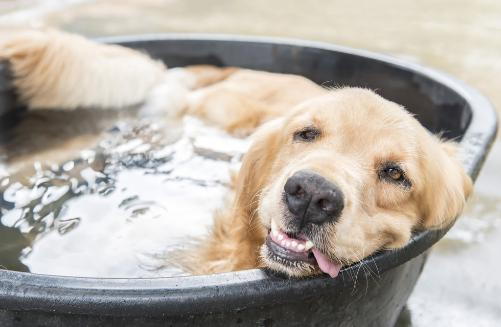
- posted: Jun. 29, 2018
Heatstroke and Hyperthermia
Hyperthermia is an elevation in body temperature that exceeds the normally accepted range. Although these normal values can vary slightly, it is usually considered to be abnormal if body temperature rises above 39oC (103oF).
Heatstroke is a form of non-fever hyperthermia that occurs when the body cannot accommodate the excessive external heat. This can set in rapidly and quickly lead to multiple organ dysfunctions. Some causes of non-fever hyperthermia can include excessive exercise, increased levels of thyroid hormones in the body, and lesions in the hypothalamus (portion of the brain that regulates body temperature).
Heatstroke more commonly affects dogs rather than cats, and although it can affect any breed, long-haired dogs and brachycephalic breeds (squishy faced) such as pugs and boxers are more at risk. It can also occur at any age; however young dogs are more commonly affected.
Some Signs and Symptoms:
- Panting
- Dehydration
- Excessive salivating/drooling
- Increased body temperature
- Reddening of gums and tongue
- Lack of urine output
- Rapid heart rate
- Irregular heart beats
- Vomiting
- Changes in mental awareness/ lack of coordination
- Diarrhea
- Seizures
- Muscle tremors
- Unconsciousness
Causes of Heatstroke:
- Excessive environmental heat due to weather conditions and/or being in an enclosed, unventilated room/car.
- Upper airway disease that restricts breathing; this includes the nose, nasal passages, throat, and windpipe.
- Underlying disease involving the heart, blood vessels, nervous system and/or musculoskeletal system.
- Poisoning. Poisoning can lead to seizures therefor leading to an increase in body temperature.
- Excessive exercise.
Who is most at risk:
- Patients with previous history of heart-related disease
- Age extremes (very young, very old)
- Heat intolerance due to poor acclimatization to the environment
- Obesity
- Poor heart/lung conditioning
- Underlying heart/lung disease
- Increased levels of thyroid hormone (hyperthyroidism)
- Short-nosed, flat-faces breeds (brachycephalic)
- Thick hair coat
- Dehydration, insufficient water intake/ restricted access to water
Treatment
Early recognition of the symptoms is key to a quick recovery. The first step in treatment is to attempt to lower the body temperature if the heatstroke is due to environmental factors such as outdoor weather, enclosed room/car or excessive exercise.
The use of cool (not ice cold) water on damp towels or by spray bottle can be used with caution as not to lower the body temperature below normal (38oC). It is important to be cautious of how cold the water actually is as temperatures too low may cause blood vessels to constrict and therefore decrease heat dissipation. We also want to prevent shivering as this causes internal heat within the body. It is important to remember that cool water for drinking should be available to your pet at all times, however steer clear of ice cold water as lowering the body temperature too rapidly can lead to other health problems.
It is also important to remember that pavement and areas like tennis courts get extremely hot on hot days and can burn your pets’ feet so you should try to avoid walking your dog on hot pavement. Signs of burnt pads include; discomfort, licking and/or holding up the feet, limping or vocalizing when the paw is touched. You can also see burns with the naked eye and, in really bad cases, the paw pad can turn red, blister and the skin will start sloughing off.
Heat exhaustion can be life threatening for your pet, so if you suspect your pet has heat stroke, go to the nearest veterinarian immediately.
Dogs suffer from heatstroke and die every year when owners leave them in parked, hot cars. Leaving the windows down or parking in the shade is not enough to prevent this. Vehicles trap heat and act like ovens. On a warm day, even vehicles parked in the shade with windows down can reach a temperature of 49oC (120oF) in minutes.
One quick errand can turn dangerous in minutes, so leave your pet safely at home.
Did you know:
Your pet doesn’t sweat like you do – they release heat by panting. Animals can’t cool down while breathing hot air! It only takes a few minutes for your pet’s body temperature to increase, leading to heat stroke, and possible organ damage. Heat exhaustion can be life threatening; if you suspect your pet has heat stroke, go to the nearest veterinarian immediately
Need to know:
If a pet reaches a point of distress in your vehicle, you may be subject to:
- Seizure of your pet, a maximum fine of $20,000, and a lifetime animal ownership ban
- Up to 6 months in jail under the criminal code of Canada
Leave your pet at home, visit pet-friendly establishments, or bringing an adult passenger along to stay in the vehicle.
Please remember, hot dogs are for bbqs… don’t leave your furry friend in a hot car.
Office Hours
8:00 AM - 8:00 PM
9:00 AM - 2:00 PM
Closed
Location
2319 Lakeshore Rd W.
Oakville, ON L6L 1H2, Canada


